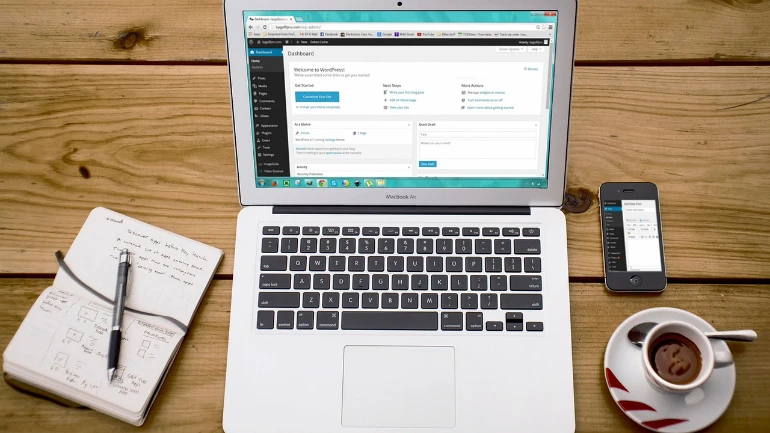How to Start an Online Store (in 9 Easy Steps)
Online shopping has changed consumer behavior forever. If you sell any products or services, you can generally benefit from selling them online. However, breaking into the world of e-commerce and launching your own online store can be daunting.
Thankfully, with the right tools you can build a fast, reliable online store without having to write a single line of code. Using these tools, you can launch your e-commerce business and start collecting payments, with minimal effort and very few upfront costs.
In this article, we’ll show you how to launch an e-commerce store using WordPress and the popular WooCommerce platform. Along the way, we’ll share advice on how to maximize your sales, by prioritizing your store’s performance and Search Engine Optimization (SEO). Let’s get started!
Why You’d Want to Start an Online Store
Over the last few years, e-commerce has completely changed consumer habits. Today, online shopping is an indispensable part of the global economy, and online-only stores such as Amazon and eBay are some of the biggest names in retail. It’s difficult to even imagine a modern company that doesn’t offer customers the option to purchase products and services online.
In 2019, retail e-commerce sales worldwide amounted to $3.53 trillion, and 2020 seems set to be a record-breaking year for online retail. Throughout 2020, physical stores around the globe were forced to close in an attempt to help combat the COVID-19 pandemic. This caused online shopping to skyrocket, as consumers embraced e-commerce as a way to access goods and services in a safe environment. In June 2020, global retail e-commerce traffic stood at a record 22 billion monthly visits.
With more people shopping online than ever before, you could find a large audience for your e-commerce business. By launching your online store now, you can maximize sales while helping your customers access the goods and services they need, without the risks currently associated with in-person shopping.
Introducing the WooCommerce Platform
There are a number of e-commerce plugins available for WordPress. However, with over five million active installs, WooCommerce is one of the most popular e-commerce platforms.
Out-of-the-box, WooCommerce provides everything you need to build an engaging online store, sell products, and accept payments. This has made WooCommerce a popular choice among online stores of all shapes and sizes.
Today, WooCommerce is used by many big-name brands. Aeropress, Weber, and the All Blacks all rely on WooCommerce to power their online stores.
There’s also evidence to suggest that WooCommerce can help you build a successful e-commerce store. According to research, 28 percent of the top one million e-commerce stores use WooCommerce as their e-commerce technology of choice.
WooCommerce was originally developed by WordPress theme developer WooThemes. However, in 2015, WooCommerce was acquired by Automattic – the company behind WordPress – who run and operate WooCommerce today.
As an Automattic product, WooCommerce is a stable, reliable e-commerce solution that’s regularly updated. If you want to create an online store, it’s always worth considering WooCommerce.
Why Build Your e-Commerce Store With WooCommerce
As a free WordPress plugin, WooCommerce is accessible to organizations of all shapes and sizes. This includes startups and smaller businesses, who typically have tighter budgets than established enterprises. Using WooCommerce, you can launch an e-commerce store with minimal upfront costs.
WooCommerce has a range of features built-in, but it’s also extensible. If vanilla WooCommerce doesn’t meet all your needs, you can choose from a wide range of WooCommerce extensions.
If you can’t find the perfect extension ready-made, WooCommerce is open-source software. This means you can always modify or extend the WooCommerce code to suit your exact needs – or hire a coder to make these changes for you.
WooCommerce is also designed to be user friendly. Using WooCommerce, you can potentially build a professional e-commerce store without having to write a single line of code. If you have previous experience with WordPress, building a store using WooCommerce will likely feel intuitive and easy.
Collecting payments is one of the most important parts of running a successful e-commerce business. WooCommerce can securely accept cards, mobile wallets, and bank transfers. It also integrates with over 100 payment gateways including PayPal, Stripe, and Square.
Today, many customers shop on their smartphones and tablets. In 2017, $1.4 trillion of total retail e-commerce sales were made using a mobile device. In 2021, it’s estimated that mobile e-commerce could account for $3.5 trillion of total e-commerce sales.
If you’re going to maximize your revenue, it’s essential your e-commerce store is mobile-friendly. WooCommerce works across all devices, including smartphones and tablets. The WooCommerce team is also continuously improving the plugin’s performance for mobile. For example, WooCommerce 3.0 optimized the product gallery for mobile users, and added support for touch gestures.
How to Start an Online Store (In 9 Easy Steps)
In this section, we’ll show you how to build a complete e-commerce store, using WooCommerce and WordPress. As promised, you won’t have to write a single line of code. Let’s dive in, and start your e-commerce business!
-
Choose the Right Web Hosting Provider
Your choice of hosting provider has the potential to make or break your e-commerce business. Downtime is always bad news, but for e-commerce stores downtime can mean an immediate drop in sales. To avoid downtime, we recommend opting for a provider that offers an uptime guarantee.
Performance is another crucial factor, as today’s consumer isn’t willing to wait around. Amazon calculated that a page load slowdown of just one second would cost them $1.6 billion in lost sales each year.
Performance can also impact your e-commerce store’s SEO. In particular, it can affect how quickly crawlers can index your content and serve it to customers. If your hosting provider doesn’t prioritize speed, your latest products and special offers may not even appear in Google’s search results for a significant period of time.
Google also uses page speed as a ranking factor in both its desktop and mobile search results. Research indicates that 39 percent of online purchases are influenced by a relevant search. Where your store appears in Google’s search results can have a huge impact on your sales and revenue.
There are many factors that can impact your site’s performance. However, your choice of hosting provider is one of the most important decisions you can make, particularly at this early stage.
At A2 Hosting, we take performance seriously. That’s why we’ve created a series of e-commerce hosting plans that are optimized for WooCommerce. These plans can deliver 20X faster page loads than competing WooCommerce hosting providers.
2. Set up WooCommerce
After activating the WooCommerce plugin, you’ll encounter a Welcome to WooCommerce screen. This is the WooCommerce configuration wizard, which is the quickest and easiest way to create a basic e-commerce store. By completing the wizard’s various screens, you can fast-track through much of the initial configuration, and get your e-commerce business off to a strong start.
If you accidentally dismiss the Welcome message, don’t panic! You can simply select WooCommerce from WordPress’ left-hand menu. WordPress will now display a list of all the steps required, in order to successfully complete the initial WooCommerce configuration.
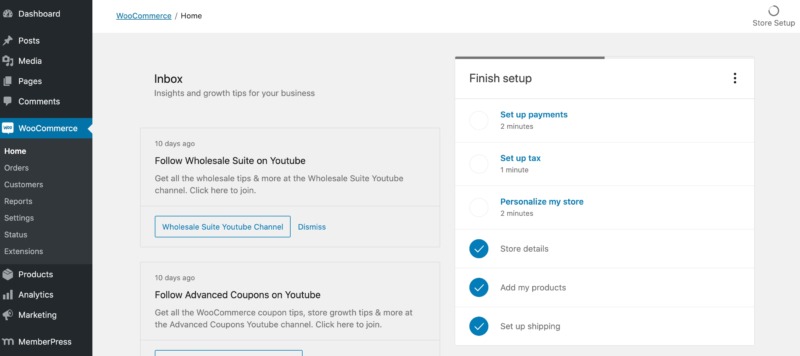
You can now work your way through this list, by clicking each item in turn and following the onscreen instructions. Once you’ve successfully completed each task, it’s time to progress to the next step.
3. Add Extra Payment Gateways
As part of the setup process, WooCommerce will prompt you to add a payment gateway. A payment gateway enables customers to pay for goods and services using a payment system such as PayPal. By default, WooCommerce supports a number of core payment gateways. However, you can also add payment gateway extensions.
As part of the initial setup process, WooCommerce should prompt you to add at least one payment gateway. However, to maximize revenue we recommend offering at least two payment gateways.
There’s no guarantee all your customers will have access to the same payment gateway. Some gateways may also experience downtime. If you only support a single gateway, you’ll be unable to process payments until that gateway is back online. This could result is missed sales, and a significant amount of frustration on behalf of your customers.
Payment gateways may also have varying rules, regulations, and associated charges. Depending on factors such as geographical location, some payment gateways may represent better value for you and your customers.
You can enable additional payment gateways, by navigating to WooCommerce > Settings and then selecting the Payments tab. This screen displays all the payment gateways WooCommerce supports.
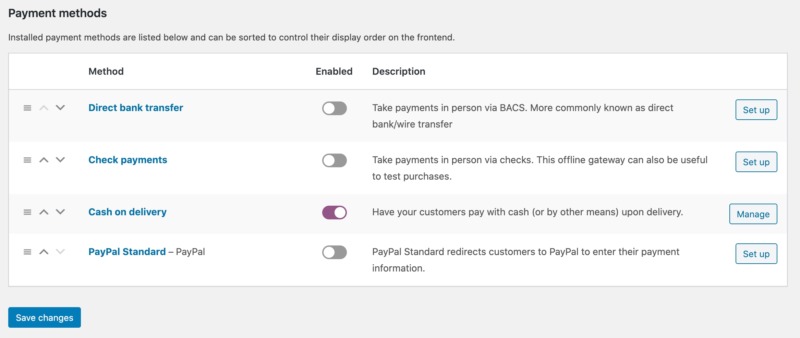
To add a payment gateway, click its accompanying Set Up button. This will open a menu where you can configure your chosen gateway. For example, if you’re configuring PayPal you’ll need to enter your PayPal email address and PayPal API credentials.
Once you’ve configured your payment gateway, select Save Changes. You can then enable the payment gateway by pushing its accompanying slider into the on position.
You can repeat these steps to enable multiple payment gateways. Just be wary of offering too much choice, as a list of unfamiliar payment options could potentially confuse your customers.
4. Create Your Product Categories
Product categories are an important way to organize your products, and help visitors find the items that matter to them. To ensure your e-commerce site is easy to navigate, it’s worth taking the time to define your product categories in advance.
You can always create more product categories as your store grows. However, by defining some product categories now, you can lay the foundations for an organized, logical e-commerce store.
To create a product category, navigate to WooCommerce > Categories. In Add New Category, enter the name of the parent category that you want to create.
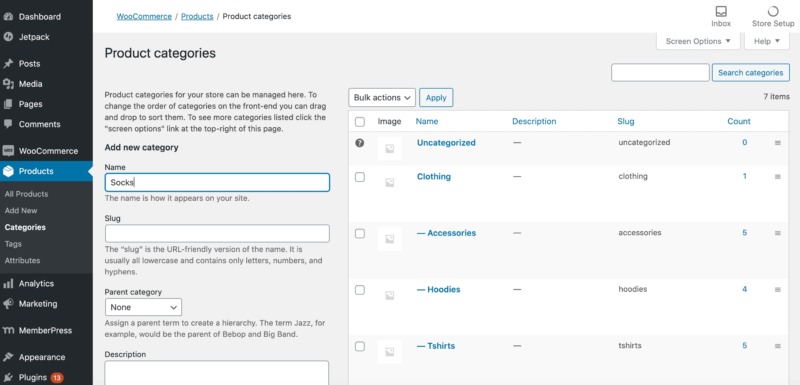
In Description, provide a description for this particular category. By adding a description to each product category, you can help search engines such as Google understand your site’s content, and rank it appropriately. Relevant, keyword-rich product descriptions can also help boost your Search Engine Optimization (SEO).
Once you’re happy with the information you’ve entered, select Add New Category. Rinse and repeat to create multiple categories.
You may also want to create product subcategories. For example, you might create a Clothing category consisting of Sweatshirt, T-shirt, and Jeans subcategories. To create a subcategory, open the Parent Category drop-down. You can then select the parent category that you want to assign to this subcategory.
5. Create Shipping Zones and Shipping Methods
If you’re going to physically ship products to your customers, it’s important to create at least one Shipping Zone. A Shipping Zone might be a country, region, or even a specific zip code where you ship your items. Your customers will see only the shipping methods that are available for their zone.
To create a shipping zone, navigate to WooCommerce > Settings > Shipping. You can then select Add shipping zone.
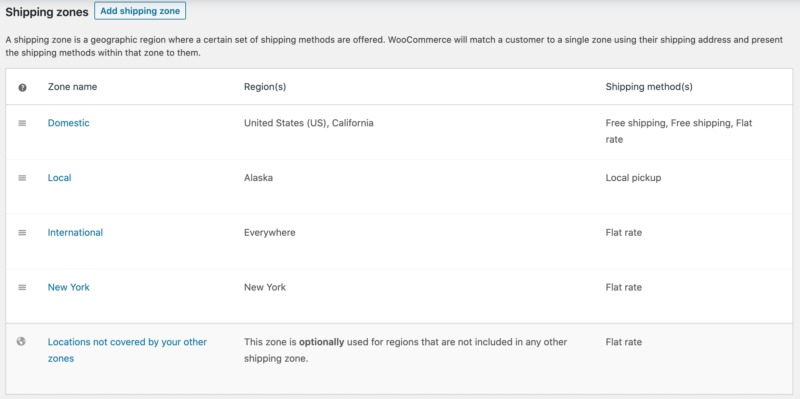
Give your zone a name, choose a region, and select Add shipping method. WooCommerce supports several shipping methods by default, including free shipping.
According to a recent survey, almost half of consumers prefer stores that offer free shipping. What’s more, 77 percent identify free shipping as the most important factor when making purchasing decisions. To drive conversions, you may want to offer free shipping when certain conditions are met.
WooCommerce also provides a local pickup option. This is great if you’re selling bulky items that are expensive to ship, or you anticipate lots of local trade. Note that if you offer local pickup then store base taxes will apply regardless of the customer’s address.
Make your selection, then click Add shipping method. You can repeat these steps, to create multiple shipping zones.
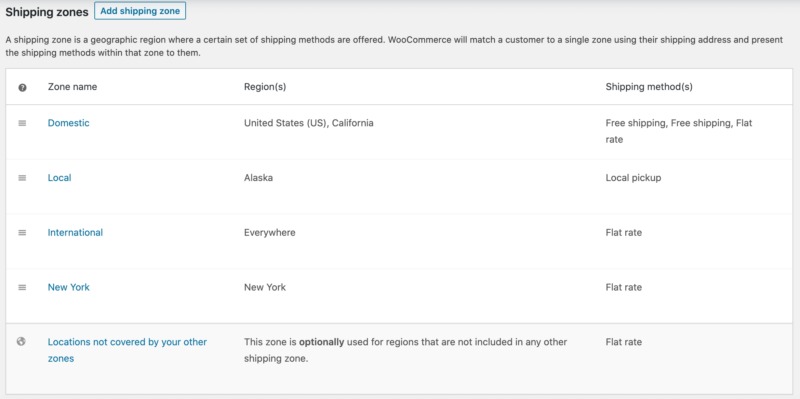
By default, WooCommerce generates the following option: Locations not covered by your other zones. If no appropriate zone is found, WooCommerce will default to this shipping zone. You can edit or delete this zone, as required.
You can also add more shipping options, using a WooCommerce shipping plugin. These plugins give your customers more options, and some even integrate with well-known shipping services such as DHL. Some popular choices include WooCommerce ShipStation Integration, and Advanced Shipping.
6. Create Your First WooCommerce Product
It’s time to stock those shelves! To create a product, select Products > Add New from WordPress’s left-hand menu. You can then give this product a name, enter a description, and upload some images that represent the item or service you’re selling.
Next, open the Product data drop-down menu and specify the type of product you want to create. Here, you have a few choices. WooCommerce supports simple products, which are defined as products that are shipped and have no options. The opposite of a simple product is a variable product. A variable product has multiple options, for example a coat that’s available in different sizes and colors.
A grouped product is a collection of related items. Finally, an external/affiliate product is sold on a third-party website, but featured on your e-commerce store.
The next steps will vary, depending on the type of product you’re creating. For example, if you select Grouped product, you’ll be prompted to enter the product’s Stock-Keeping Unit (SKU). This is a unique string that represents this product in your e-commerce store. Alternatively, if you select Simple Product, you’ll be prompted to specify whether this product is downloadable.
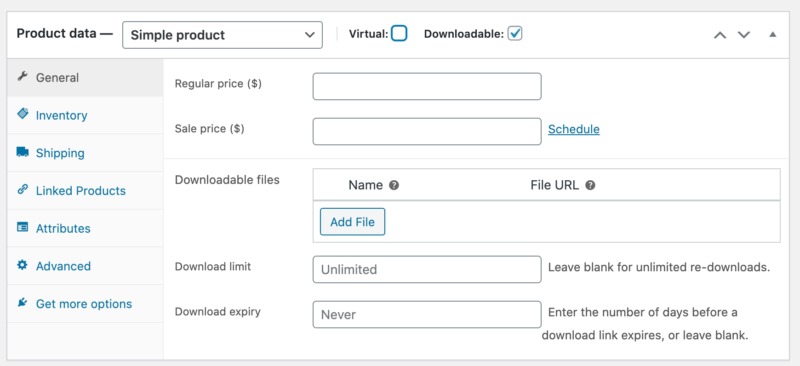
After creating your product, it’s time to set your price. You can specify the everyday, non-sale price in the Regular price field.
You can now assign this product to at least one category, and add product tags. Both of these elements are essential for helping visitors navigate your store, and find the exact items they want to buy.
7. Create an Inventory and Stock Notifications
At this point, we’ve entered some basic information about our product. However, before we go ahead and publish the product, it’s a good idea to perform some stock management. This involves entering the total number of units currently in stock, and configuring some optional low stock warnings.
Stock management ensures you know when to order more stock. It also helps you avoid unpleasant situations, where you have to explain to customers that the product they’ve just paid for isn’t actually in stock.
To start, select the Inventory tab and create an SKU for this product. You can then enter the number of units you currently have in stock.
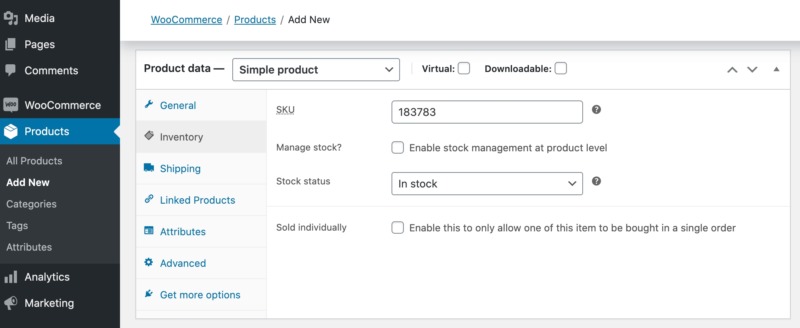
WooCommerce can email you when you’re running low on stock. If you want to receive these notifications, select the following checkbox: Enable stock management at product level. In Low stock threshold, specify the point where you’d consider this product to be approaching low stock.
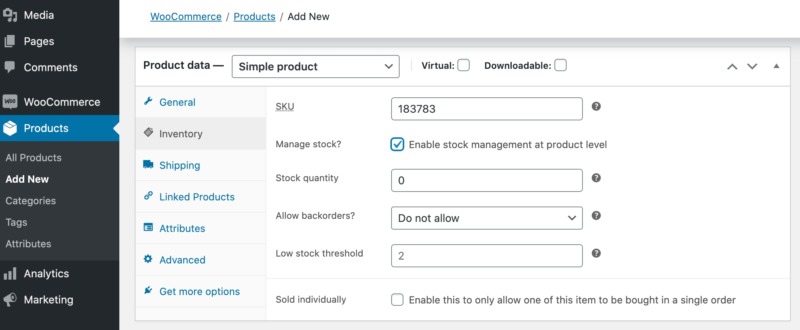
By default, WooCommerce doesn’t allow for back orders. However, back orders can help you secure sales, even when an item isn’t currently available. This can be particularly useful during peak retail seasons, where it’s generally accepted that some items may be temporarily out of stock.
If you want to permit back orders, open the Allow back orders drop-down. You can then select either Allow or Allow, but notify customer. If you choose the latter, the product page will display an Available on back order notice. The customer can then decide whether to purchase this product, fully aware that it’s not currently in stock.
8. Build an eBay-Style Product Menu
To drive conversions, your customers should be able to find their perfect product, in just a few clicks. WordPress supports a range of navigational menus. However, drop-downs are particularly popular, as selecting a parent category displays all the associated product subcategories. This is exactly what we see with many popular e-commerce sites, including eBay.
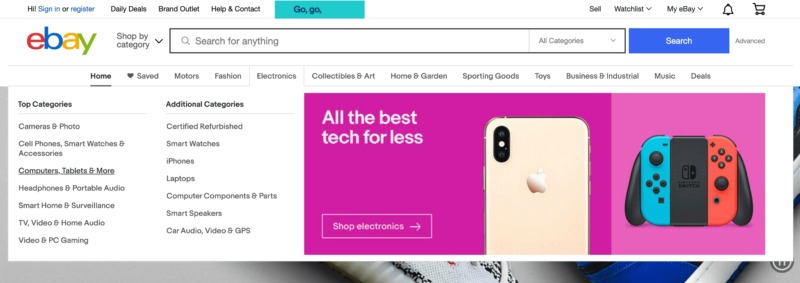
By default, you can’t add product categories to a WordPress menu. To enable product categories, select Appearance > Menus > Screen Options. You can then select Product Categories.
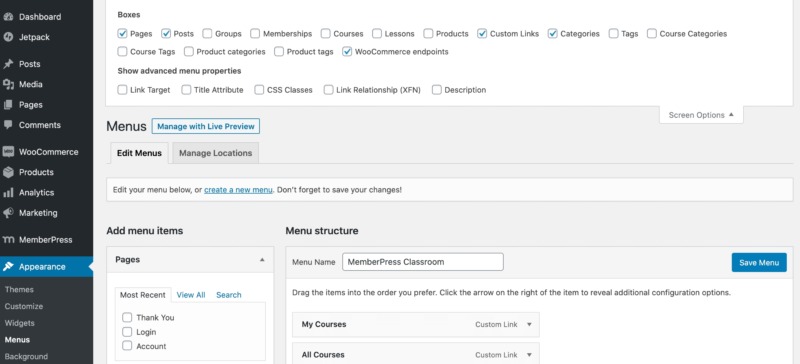
Next, scroll to the Add menu items section. You can now add product categories to your WordPress menus.
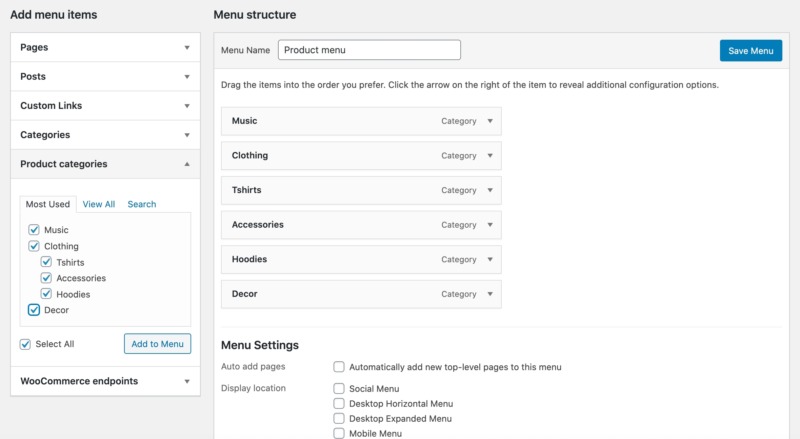
Since we’re creating a drop-down menu, position each subcategory beneath its parent. You can then grab each child category and drag it slightly to the right, so it appears indented beneath its parent.
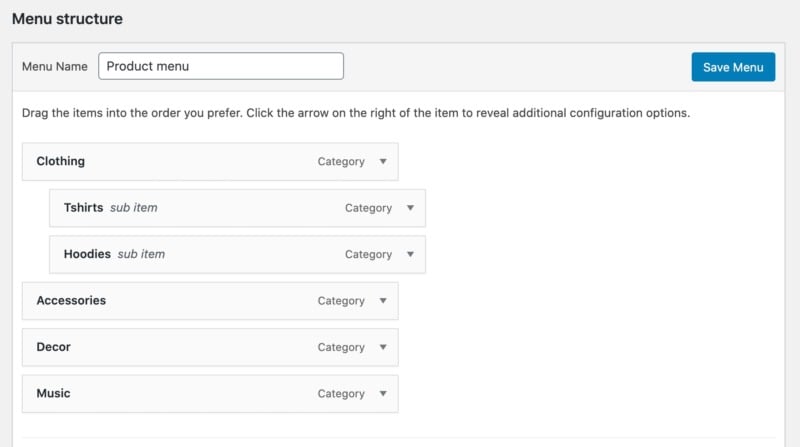
You can now create your menu, as normal. To ensure this menu appears across your entire e-commerce store, we recommend setting it as your top menu.
9. Boost Your Revenue With Related Products
As an e-commerce store, you’ll naturally want to push customers towards purchasing additional products, or more expensive alternatives. One method is to display related products.
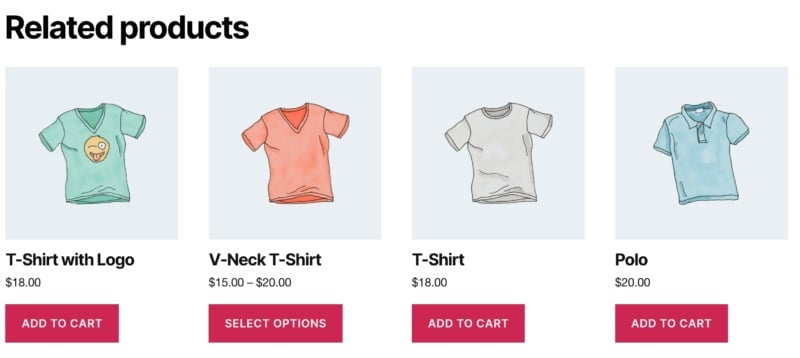
WooCommerce tries to generate related products automatically. However, you can often get better results by linking products manually. To start, navigate to Products > All Products. You can then open any product for editing, and select its Linked Products tab.
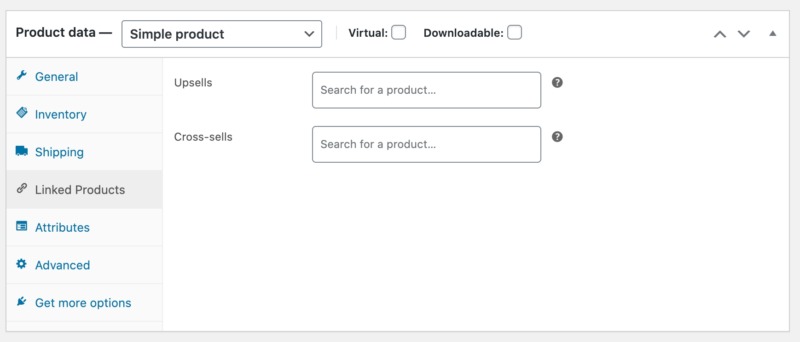
You can define two types of linked products: ‘upsells’ and ‘cross-sells’. Upsells are typically more expensive alternatives, whereas cross-sells are complimentary items. For example, potential cross-sells for a laptop might include a Bluetooth mouse, or a laptop bag.
Conclusion
If you sell products or services, chances are your customers are already online and looking to make a purchase. If you aren’t offering your goods via an e-commerce platform such as WooCommerce, you could be missing out on sales.
When building your online store, we’d recommend paying particular attention to your product tags and categories. These elements are often overlooked, but are vital for Search Engine Optimization (SEO).
To climb Google’s search engine rankings, it’s also important to choose the right hosting provider. By opting for a hosting package that delivers high performance and an uptime guarantee, you can give your store the best possible chance of attracting a large volume of traffic, and securing lots of conversions.
Image credit: freestocks.




